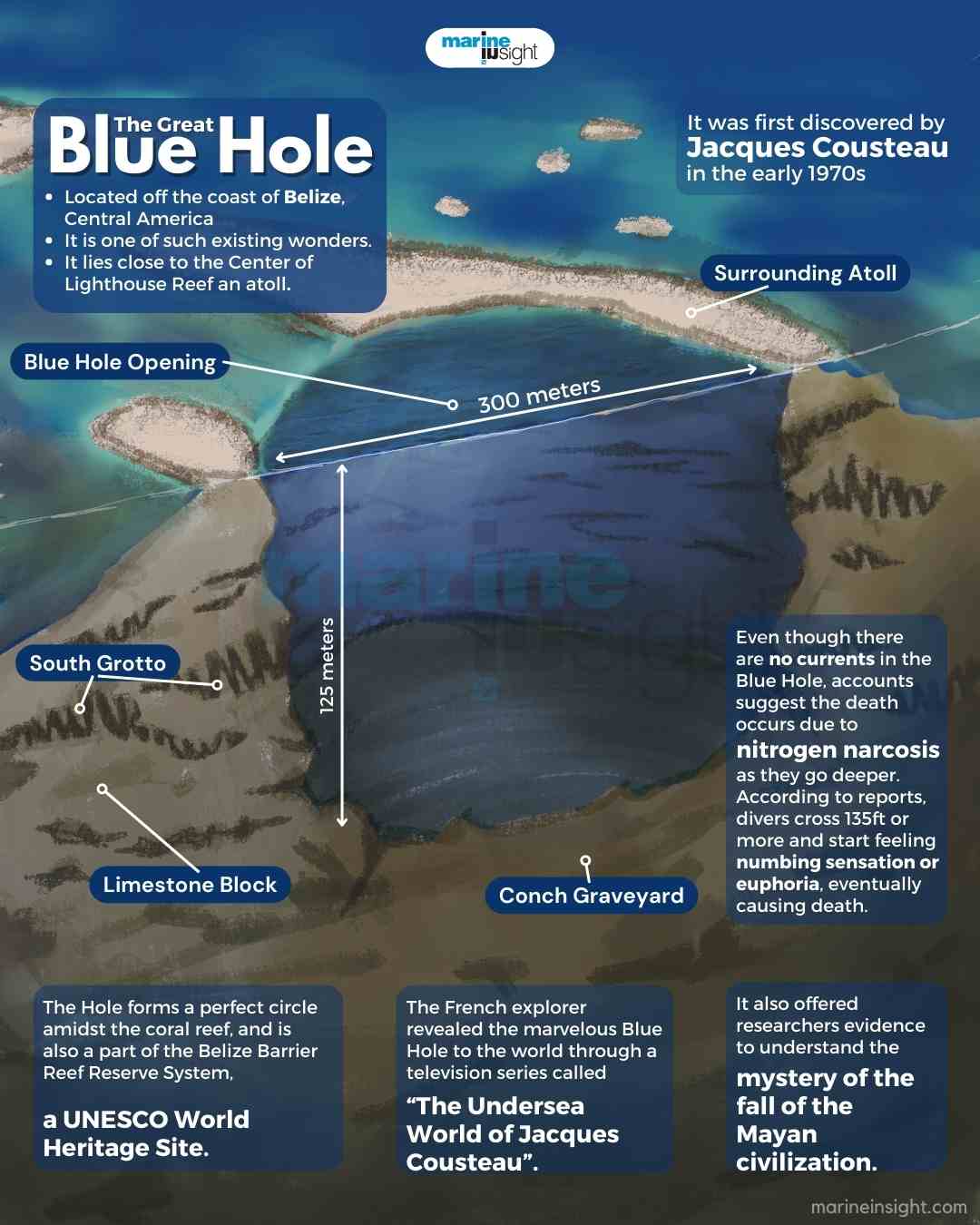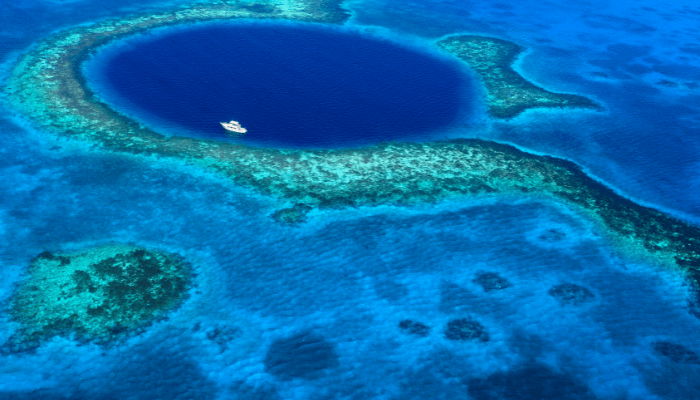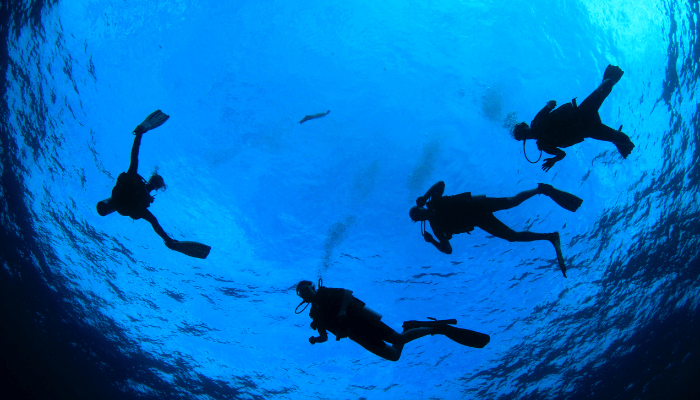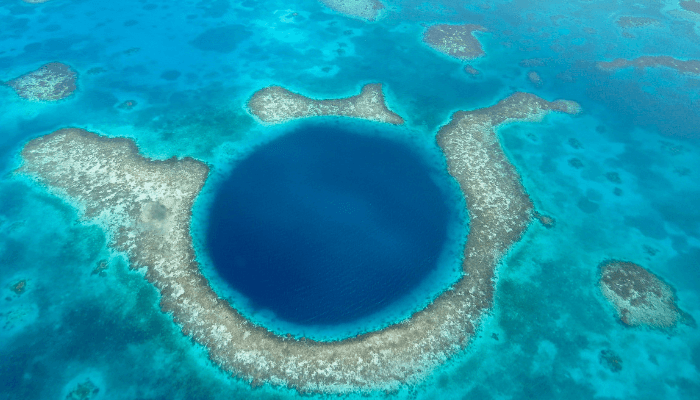What is the Great Blue Hole of Belize?
Instead of its roaring waves and scary storms, the calm ocean offers amazing natural wonders below its otherwise uncertain surface. The Great Blue Hole of Belize, located off the coast of Belize, on the eastern coast of Central America, is one of such existing wonders. It lies close to the Center of Lighthouse Reef, an atoll about 100 km from the mainland city of Belize.
It is located in the lighthouse reef atoll, one of the three atolls of Belize. There are five islands inside the reef, popular ones being Half-moon Caye, Ambergris Caye and Long Caye. Another beautiful place is the turneffe islands. These places are fascinating and perfect for full-day trips.
Researchers say this giant underwater sinkhole was made by the collapse of a cavern formed during the glacial ages tens of thousands of years ago. This swallow hole is one of the world’s most famous diving zones and is home to the Caribbean reef sharks, nurse sharks, hammerhead sharks and blacktip sharks.
The Hole forms a perfect circle amidst the coral reef, known as the Lighthouse Reef and is also a part of the Belize Barrier Reef Reserve System, a UNESCO World Heritage Site.
The Great Blue Hole of Belize features more than 300 meters (984 ft) across and 125 meters (410 ft) deep. Researchers consider the Great Blue Hole the largest of its kind and discovered huge stalactites, dripstone sheets, and columns inside the Blue Hole.
Water levels in the surrounding areas of the sinkhole are so shallow that the coral often breaks the surface at low tide. The watercolour of the swallow hole is deep blue in contrast with the aquamarine colour of the water neighbouring it.
The Hole has got a great fan following in the world, and the Belize locals have a keen desire to have the Hole anointed with the title of being one of the world’s seven wonders. The Discovery Channel, in 2012, announced the Great Blue Hole as number one on its list of “The 10 Amazing Places on Earth”.
History of the Great Blue Hole of Belize
Researchers suggested that this massive submarine sinkhole was initially formed during the last glacial period as a limestone cave system when the sea levels were lower. However, the cave was later flooded when the sea began to rise, eventually forming a circular hole.
Because of the increasing water levels and the consequent rise in the ocean level, the cavern’s roof was brought down while the inner portion remained intact, albeit submerged under the deluge of the water.
A plethora of analyses has claimed that the period of formation of the Blue Hole was 153000, 66000, 60000 and 15000 years ago. And the name “The Great Blue Hole” was given to the Hole by British diver and author Ned Middleton in his book “Ten Years Underwater.” He reasoned that if Australia could have the Great Barrier Reef, Belize city could also have the Great Blue Hole.
The uniqueness of the Belize Hole came to light first when the world-renowned explorer of that time, Jacques Yves-Cousteau, made a pioneering discovery about its in-depth coffers with the help of his vessel – The Calypso – in the early 1970s. The French explorer revealed the secrets of the marvellous Blue Hole to the world through a television series called “The Undersea World of Jacques Cousteau”.
In addition, the studies undertaken by the explorer and his crew initially suggested that the Blue Hole in Belize was a limestone cavern of the glacial era formed due to the shallowness of the water.
Underneath the surface of the Belize Blue Hole, the explorers found evidence of a hollow interior filled with stalactites and stalagmites.
These stalactites acted as veritable proof for the explorers to conclude that the Hole was a swallow hole. The depth of the Great Blue Hole was initially measured as 125 m (410 ft), while another expedition conducted by the Cambrian Foundation claimed the depth as 124 m (407 ft) in 1997.
Meanwhile, the Blue Hole also offered researchers evidence that helped them understand the mystery of the fall of the Mayan civilization.
Researchers from Rice and Louisiana State Universities, in a study published in 2015, have presented the evidence found in the cave, supporting the role of climate conditions that ended the civilization.
The cave’s sediment and lagoon samples helped them support theories that suggest there were fewer tropical cyclones and longer droughts than normal during the era of the Mayan decline.
The scuba dive site and marine life
The Blue Hole in Belize is unlike any other swallow hole and is regarded as the world’s biggest marvel. Mr Cousteau accorded the swallow hole the honour of being one of the world’s top 10 zones for scuba diving enthusiasts.
The moderate temperatures of the country allow potential divers to penetrate the depths of the Belize Hole all year round. Likewise, the complete absence of water currents and acute temperature changes in the swallow hole allows divers to try and make a foray all year round.
The average temperature in the Blue Hole is reportedly about 76F at 130ft, with little difference throughout the year. The descriptions of the divers pointed to the amazing beauty underneath the waters with those geological formations and also suggested that the water becomes clearer when one goes deeper.
On account of the intense depth of the Hole, only experienced divers are advised to enter it. TOnlyexperienced divers can stabilize their bodies while deep diving and bringing themselves upwards.
In addition to the crystal clear water that tempts divers, the reef surrounding the Hole is home to many exotic fishes like the nurse tip shark, reef shark native to the Caribbean and various other marine creatures.
Despite these, there have been reported sightings of several other species, including Midnight Parrotfish, the bull shark, hammerheads and other juvenile fish species. However, reports also suggest that the marine life in the Hole is relatively low, and most of the time, species like sharks pass through.
Accidents and presence of Monster in Blue Hole
Despite its beauty, the Great Blue Hole of Belize also often witnesses accidents, including the death of divers. According to reports, several divers have so far lost their lives in the darkness of the Blue Hole for various reasons.
Even though there are no currents in the Blue Hole, accounts suggest the death occurs due to nitrogen narcosis as they go deeper. According to reports, divers cross 135ft or more and start feeling numbing sensation or euphoria, eventually causing death.
Interestingly, there are also stories of monsters in the Great Blue Hole of Belize doing rounds. A diving expedition from Caye Caulker in the early 1970s claimed the presence of monsters in the waters, saying they had witnessed an apparition of a sea serpent. According to the claims, the sighted beast was 20 long and had red eyes.
However, the claims couldn’t give any other pieces of evidence rather than creating some apprehension in the minds of the divers. At the same time, few suggested, pointing to the description, that the one they saw must be species like ribbon fish or oarfish.
Ignoring such doubtful claims, thousands of divers visit the Great Blue Hole of Belize every year to explore the brilliance of nature. The Great Blue Hole of Belize is a natural marvel among the most amazing places on earth.
Frequently Asked Questions
1. What is inside the Great Blue Hole?
It is one of the unique natural formations of the Belize Barrier Reef System. It is home to giant stalactites, dripstone sheets and columns, not to forget the various marine flora and fauna.
2. What is so special about the Great Blue Hole?
The Great Blue Hole is a famous scuba diving spot. Scuba divers can enjoy the crystal clear waters and the company of many fish species, including the midnight parrotfish, the Caribbean reef shark and other juvenile fish species.
3. How many bodies are in the Blue Hole?
The Blue Hole is famous for freediving due to its easy access from the shore and lack of current. However, it has one of the highest diving fatalities in the world, with an estimated death of 150 to 300 divers in recent years.
4. Can you snorkel near the Great Blue Hole?
One would need an entire day to cover the whole area, which might not be the best snorkelling experience. However, some believe it is worth going, especially if it is a part of a day trip to visit multiple places.
5. Why is Great Blue Hole so famous?
It is a unique site off the coast of Belize, known as a wonder of the marine world. The submarine sinkhole covers 984 feet and has a depth of 124 feet. Recreational divers from all over the world visit the place to enjoy an unforgettable diving experience.
You might also like to read
- 10 Amazing Sea Water Caves
- 15 Brave Organisations Fighting To Save Our Oceans
- Concept: Ocean Bricks make Artificial Islands a Possibility
- 10 Major Facts About Sulu Sea You Must Know
- The Beautiful World of the Caribbean Cruises
- Watch: How An IMO/EU Initiative Is Helping Cut Maritime Emissions
Disclaimer: The author’s views expressed in this article do not necessarily reflect the views of Marine Insight. Data and charts, if used, in the article have been sourced from available information and have not been authenticated by any statutory authority. The author and Marine Insight do not claim it to be accurate nor accept any responsibility for the same. The views constitute only the opinions and do not constitute any guidelines or recommendation on any course of action to be followed by the reader.
The article or images cannot be reproduced, copied, shared or used in any form without the permission of the author and Marine Insight.
Do you have info to share with us ? Suggest a correction
Subscribe To Our Newsletters
By subscribing, you agree to our Privacy Policy and may receive occasional deal communications; you can unsubscribe anytime.







